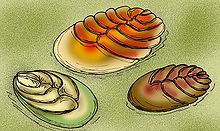Vendiamorpha
| Vendiamorpha | |
|---|---|

| |
| Paravendia janae, Vendia sokolovi, V. rachiata | |
| Scientific classification | |
| Domain: | Eukaryota |
| Kingdom: | Animalia |
| Phylum: | †Proarticulata |
| Class: | †Vendiamorpha Fedonkin, 1985 |
| Families and genera | |
| |
Vendiamorpha[1] is a class of extinct animals within the Ediacaran phylum Proarticulata.
The typical vendiamorph had an oval-shaped or round-shaped body divided completely into segmented isomers, that were arranged alternately in two rows with reference to the longitudinal axis of the body.
Description[edit]

The phenomenon of left-right alternating segments is called glide reflection symmetry, and is a diagnostic feature of proarticulatans. Transverse elements decrease in size from one end to the other and are inclined in the same direction. The larger isomers cover the smaller ones externally and the first isomer is much larger than the rest.[2][3][4]
Typically, the first few, or largest isomers are fused together to form a headshield-like structure, leading some researchers to have originally considered them to be ancestral or related to arthropods,[5][6] though, overwhelming evidence of them being proarticulatans have since led researchers to discard this hypothetical relationship.[1][2]
Some vendiamorphs (e.g., Vendia and Paravendia) supposedly demonstrate a digestive-distributive system consisting of a simple axial tube and lateral appendages, with one lateral appendage corresponding to one isomer.[2][3]
Class Vendiamorpha currently includes only one Family Vendiidae (originally referred to as Vendomiidae as the type genus Vendomia,[7] before V. menneri was redescribed as a member of Dickinsonia[8]) that consist of species Vendia sokolovi, V. rachiata, Paravendia janae and possibly Karakhtia nessovi, from Ediacaran (Vendian) rocks of the Arkhangelsk Region in Russia.[2][3][4][9]
Name[edit]
The clade name Pseudovendia refers to the resemblances to a fossil imprint described as Vendia sokolovi. Originally, that fossil was interpreted as an arthropod,[10] later as a proarticulatan,[1] then conjectured as possibly a frond-like organism.[11]
Current scientific consensus now recognizes the poorly preserved holotype of Pseudovendia as a pseudofossil.[12][13]
See also[edit]
References[edit]
- ^ a b c Fedonkin, M.A. (1985). "Systematic description of Vendian metazoa". In Sokolov, B.S.; Iwanowski, A.B. (eds.). Vendian System: Historical–Geological and Paleontological Foundation. Vol. 1: Paleontology. Moscow, RU: Nauka. pp. 70–106.
- ^ a b c d Ivantsov, A.Yu (2001). "Vendia and Other Precambrian "Arthropods"". Paleontological Journal. 35 (4): 335–343.
- ^ a b c Ivantsov, A.Yu (2004). "New Proarticulata from the Vendian of the Arkhangel'sk region" (PDF). Paleontological Journal. 38 (3): 247–253. Archived from the original (PDF) on 27 September 2007. Retrieved 27 September 2007.
- ^ a b Ivantsov, A.Yu. (2004). Vendian animals in the phylum Proarticulata (PDF). The Rise and Fall of the Vendian Biota (abstract). Prato, Italy. p. 52. IGSP Project 493.
- ^ Menner, V.V. (1963). "The other problematical organic remains". Stratigraphy of the USSR: Upper Precambrian (in Russian). Moscow, RU: Gos. Nauchno-Tekh. Izd. pp. 504–507.
- ^ Glaessner, M.F.; Wade, M. (1971). "Praecambridium - a primitive arthropod". Lethaia. 4 (1): 71–77. doi:10.1111/j.1502-3931.1971.tb01280.x.
- ^ Keller, B.M.; Fedonkin, M.A. (1976). "New records of fossils in the Valdaian group of the precambrian on the Syuz'ma River" (PDF). Izvestiya Akademii Nauk SSR. Seriya Geologicheskaya (in Russian). 3: 38–44. Archived from the original (PDF) on 27 September 2007. Retrieved 27 September 2007.
- ^ Ivantsov, A.Yu. (April 2007). "Small Vendian transversely articulated fossils". Paleontological Journal. 41 (2): 113. doi:10.1134/S0031030107020013.
- ^ Ivantsov, A.Yu.; Malakhovskaya, Y.E.; Serezhnikova, E.A. (2004). "Some problematic fossils from the Vendian of the south-eastern White Sea region" (PDF). Paleontological Journal. 38 (1): 1–9. Archived from the original (PDF) on 4 July 2007. Retrieved 8 March 2007.
- ^ Boynton, H.E.; Ford, T.D. (1979). "Pseudovendia charnwoodensis — A new Precambrian arthropod from Charnwood Forest, Leicestershire". Mercian Geologist. 7: 175–177.
- ^ Boynton, H.E. (2010). "Charnian fossils in the outwoods" (PDF). Mercian Geologist. 17 (3): 175–177.
- ^ Grazhdankin, D.V. (2007). Charnwood biota as seen from arctic Russia – Ediacarans and their environments (PDF). Leicester’s fossil celebrity: Charnia and the evolution of early life (abstract). Leicester, UK: University of Leicester. pp. 15–16.
- ^ Liu, A.G.; McIlroy, D.; Antcliffe, J.B.; Brasier, M.D. (2010). "Effaced preservation in the Ediacara biota and its implications for the early macrofossil record". Palaeontology. 54 (3): 607–630. doi:10.1111/j.1475-4983.2010.01024.x.
External links[edit]
- "Database of Ediacaran biota". Advent of Complex Life. Archived from the original on 25 July 2011.

